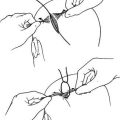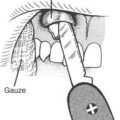WATER DISINFECTION
Water purification is the removal of chemical pollutants by filtration through activated charcoal or active resin compounds. This usually improves the taste, but does not decrease the incidence of infectious disease, because microorganisms are not removed. Water disinfection is the treatment of water with chemicals, boiling, or filtration to remove agents of infectious disease, such as bacteria and cysts. Sterilization is the removal of all life forms.
The principal offending agents in contaminated water or on unwashed food that cause illness and diarrhea are the bacteria Salmonella, Shigella, E. coli, and Campylobacter, and the flagellate protozoan Giardia lamblia (see page 207). Drinking nondisinfected water in parts of Africa, India, and Pakistan can cause dracunculiasis (guinea worm disease). In countries where water is improperly disinfected, stick to bottled or canned carbonated beverages, beer, and wine. However, be advised that even bottled water in developing countries can be contaminated with bacteria that cause diarrhea, so even bottled water should probably be boiled or disinfected with chemicals or ultraviolet (UV) light before drinking. All containers should be wiped clean to remove external moisture and dirt. All ice should be considered contaminated. For purposes of preserving the environment, it is preferable to carry a reusable water container that is filled with disinfected water than to discard multiple plastic or glass containers.
Water may be disinfected by any of the following methods:
1. The usual advice—to boil water for 5 to 10 minutes plus 1 minute for each 1,000 ft (305 m) of altitude above sea level—is probably overkill. Giardia cysts are instantly killed in water heated to 158°F (70°C). To play it safe, bacteria and most viruses require a few minutes at this temperature. Hepatitis A virus requires a full minute of boiling to ensure inactivation.
2. Add one tablet of fresh tetraglycine hydroperiodide (Potable Aqua, Globaline, Coughlan’s, EDWGT) to 1 quart (liter) of water and allow the water to stand for 15 minutes. If the water is cloudy, use two tablets. If the water is cold, allow 1 hour after adding the tablets before drinking. Each tablet releases approximately 8 mg/liter of iodine. Do not leave an open bottle exposed to high heat and/or humidity. Potable Aqua Plus includes oxidizing tablets to remove the iodine taste after disinfection.
ADD TO 1 QUART (LITER) OF WATER
| water | clear | cloudy |
|---|---|---|
| warm (>15°C, 59°F) | 1 tab for 15 minutes | 2 tabs for 30 minutes |
| cold | 1 tab for 60 minutes | 2 tabs for 60 minutes |
3. Add 8 to 10 drops (0.5 mL in each drop) of standard 2% iodine tincture per quart (liter) of water and allow it to stand for 15 minutes. Use a dropper for measurement. If the water is not at least 68°F (20°C), this technique may not eliminate Giardia. If the water is cold, allow it to stand for 1 hour before drinking. If you have extra time and do not like the iodine taste, use four to five drops of iodine and allow the water to stand for 8 hours or overnight. Five drops of tincture of iodine disperses to approximately 4 mg/liter.
ADD TO 1 QUART (LITER) OF WATER:
| water | clear | cloudy |
|---|---|---|
| warm (>15°C, 59°F) | 5 drops for 15 minutes | 10 drops for 30 minutes |
| cold | 5 drops for 60 minutes | 10 drops for 60 minutes |
ADD TO 1 QUART (LITER) OF WATER:
| water | clear | cloudy |
|---|---|---|
| warm (>15°C, 59°F) | 8 drops for 15 minutes | 16 drops for 30 minutes |
| cold | 8 drops for 60 minutes | 16 drops for 60 minutes |
4. Fill a 1 oz (30 mL) glass bottle with iodine crystals (U.S. Pharmacopeia [USP] grade, resublimed: 2 to 8 grams), and then fill the bottle with water. The bottle should have a paper-lined Bakelite cap. Warm the water to 68°F to 77°F (20°C to 25°C). Shake vigorously, and then allow the crystals to settle to the bottom for 1 hour. This will create a saturated solution of iodine. As a crude measure, pour at least half of this liquid (not the remaining crystals), or approximately 12.5 to 15 mL, through a fine filter (such as Teflon) into a quart (liter) of water and allow it to stand for 30 minutes. If the water temperature is not at least 68°F (20°C), this technique may not eliminate Giardia. The crystals may be reused up to 1,000 times. Two grams (0.07 oz) of iodine represents a potentially lethal dose if ingested, so it is absolutely essential to keep the iodine crystals out of the hands of children. A commercial iodine crystal system that can be reused to disinfect up to 2,000 quarts (liters) of drinking water is sold as Polar Pure Water Disinfectant.
ADD TO 1 QUART (LITER) OF WATER:
| water | clear | cloudy |
|---|---|---|
| warm (>15°C, 59°F) | 5 capfuls for 15 minutes | 10 capfuls for 30 minutes |
| cold | 5 capfuls for 60 minutes | 10 capfuls for 60 minutes |
ADD TO 1 QUART (LITER) OF WATER:
| water | clear | cloudy |
|---|---|---|
| warm (>15°C, 59°F) | 0.1 mL for 15 minutes | 0.2 mL for 30 minutes |
| cold | 0.1 mL for 60 minutes | 0.2 mL for 60 minutes |
5. Filter the water through a category-three (as set for purification by the Environmental Protection Agency) water treatment device. Manufacturers who sell filtration devices are Mountain Safety Research, Katadyn, AquaRain Filter Systems, General Ecology Inc., Recovery Engineering, Timberline, Stearns Outdoors Inc., McNett, and Sawyer Products. The Sawyer Point Zero Two water filter, with a 0.02 micron filter, is rated to remove viruses. This product is available with a bucket adapter kit, or can be fitted to 4 liter bags or a special water bottle.
6. Maximum filter pore sizes (in material or microns) for removing microorganisms are as follows: dracunculus (guinea worm) larvae—coffee filter or fine cloth; schistosome cercariae—coffee filter or fine cloth; parasitic eggs and larvae—20; Giardia lamblia cyst, Entamoeba histolytica cyst, Cyclospora—3 to 5; Cryptosporidium oocyst—1; enteric bacteria (such as E. coli) —0.2 to 0.4; and viruses—0.004 to 0.01.
7. Halazone (a mixture of monochloraminobenzoic and dichloraminobenzoic acids) and other chlorine (bleach) products have been considered less effective for field water disinfection. Halazone has been characterized as losing 75% of activity after 2 days’ continuous exposure to air with high heat and humidity; having a shelf life of 6 months; and decreasing potency by 50% after storage above 104°F (40°C). Therefore, you should obtain a new bottle every 3 to 6 months.
Each Halazone tablet releases 2.3 to 2.5 mg/liter of chlorine. To disinfect water:
ADD TO 1 QUART (LITER) OF WATER:
| water | clear | cloudy |
|---|---|---|
| warm (>15°C, 59°F) | 5 tablets for 15 minutes | 7 tablets for 15 minutes |
| 2.5 tablets for 30 minutes | 5 tablets for 30 minutes | |
| cold | 5 tablets for 60 minutes | 7 tablets for 60 minutes |
FOR 5.25% BLEACH, ADD TO 1 QUART (LITER) OF WATER:
| water | clear | cloudy |
|---|---|---|
| warm (>15°C, 59°F) | 2 drops (0.1 mL) for 30 minutes | 4 drops (0.2 mL) for 30 minutes |
| cold | 2 drops (0.1 mL) for 60 minutes | 4 drops (0.2 mL) for 60 minutes |
FOR 1% BLEACH, ADD TO 1 QUART (LITER) OF WATER:
| water | clear | cloudy |
|---|---|---|
| warm (>15°C, 59°F) | 10 drops (0.5 mL) for 30 minutes | 20 drops (1 mL) for 30 minutes |
| cold | 10 drops (0.5 mL) for 60 minutes | 20 drops (1 mL) for 60 minutes |
8. Superchlorination followed by dechlorination is an effective technique. This is a more complicated method that requires understanding and experience. Add 27 g or more of calcium hypochlorite crystals to a gallon (3.8 liters) of water to attain a chlorine concentration of 27 to 30 parts per million. After the requisite disinfection time (10 to 30 minutes), add six drops of concentrated (30%, caustic) hydrogen peroxide to dechlorinate the water. The chemical reaction produces calcium chloride (which remains in solution), water, and oxygen.
9. Chlorination can be combined with flocculation. AquaCure tablets contain alum and sodium dichloro-s-triazinetrione. Dropped into a liter of cloudy water, a tablet releases 8 mg/liter of free chlorine. If a tablet is dropped into clear water where the flocculation capability isn’t exhausted, the alum causes a bit of cloudiness, and there is a stronger chlorine taste.
10. Aquamira water treatment uses stabilized 2% chlorine dioxide combined with an activator (5% food grade phosphoric acid) to improve the taste of water. One kit can be used to treat more than 120 liters of water. Mix 7 drops of the two bottles together, let sit for 5 minutes, and then pour the contents into 1 quart of water. Oxygen is released in a highly active form to kill odor-causing bacteria. The process takes approximately 20 minutes.
11. The SteriPEN carries the promotional byline of “safe drinking water anywhere.” Distributed by Traveler’s Supply, Inc., this unique hand-held water purifier that uses ultraviolet light (UVL) is advertised to fit into most plastic consumer water bottles, as well as other types of containers up to 32 ounces (1 liter). It operates on four AA batteries, with nickel-metal-hydride or lithium batteries recommended. According to the distributor, only 48 seconds of exposure to the UVL is required to disinfect 16 ounces (½ liter) of water and 90 seconds for 32 ounces (1 liter). The claim is that the device is effective against common outdoor and household pathogens, as well as less common microorganisms, to include bacteria, viruses, and protozoa. The test results are found at an Internet link provided by the company. According to the product literature, the SteriPEN meets U.S. Environmental Protection Agency standards for microbiological water purifiers. A filter can be used to remove particulates from the water before UV treatment.





